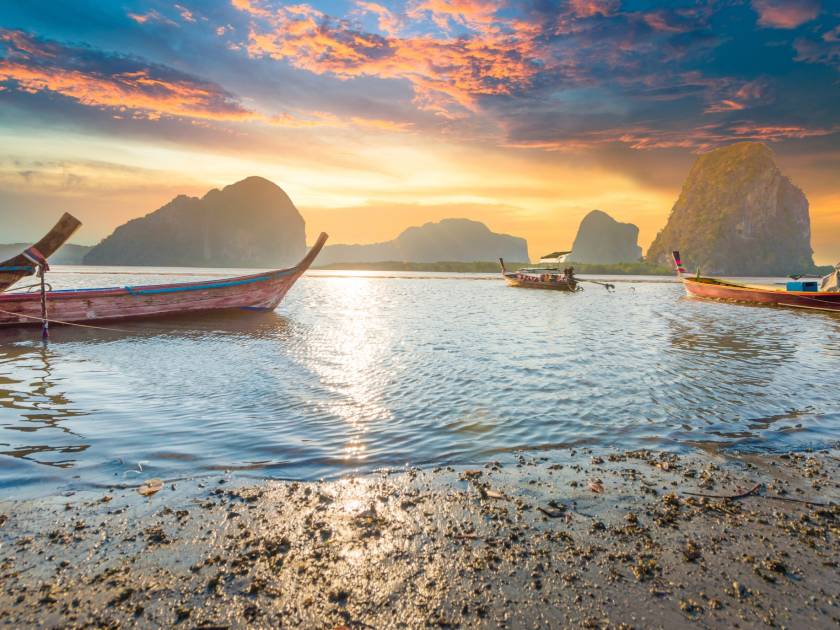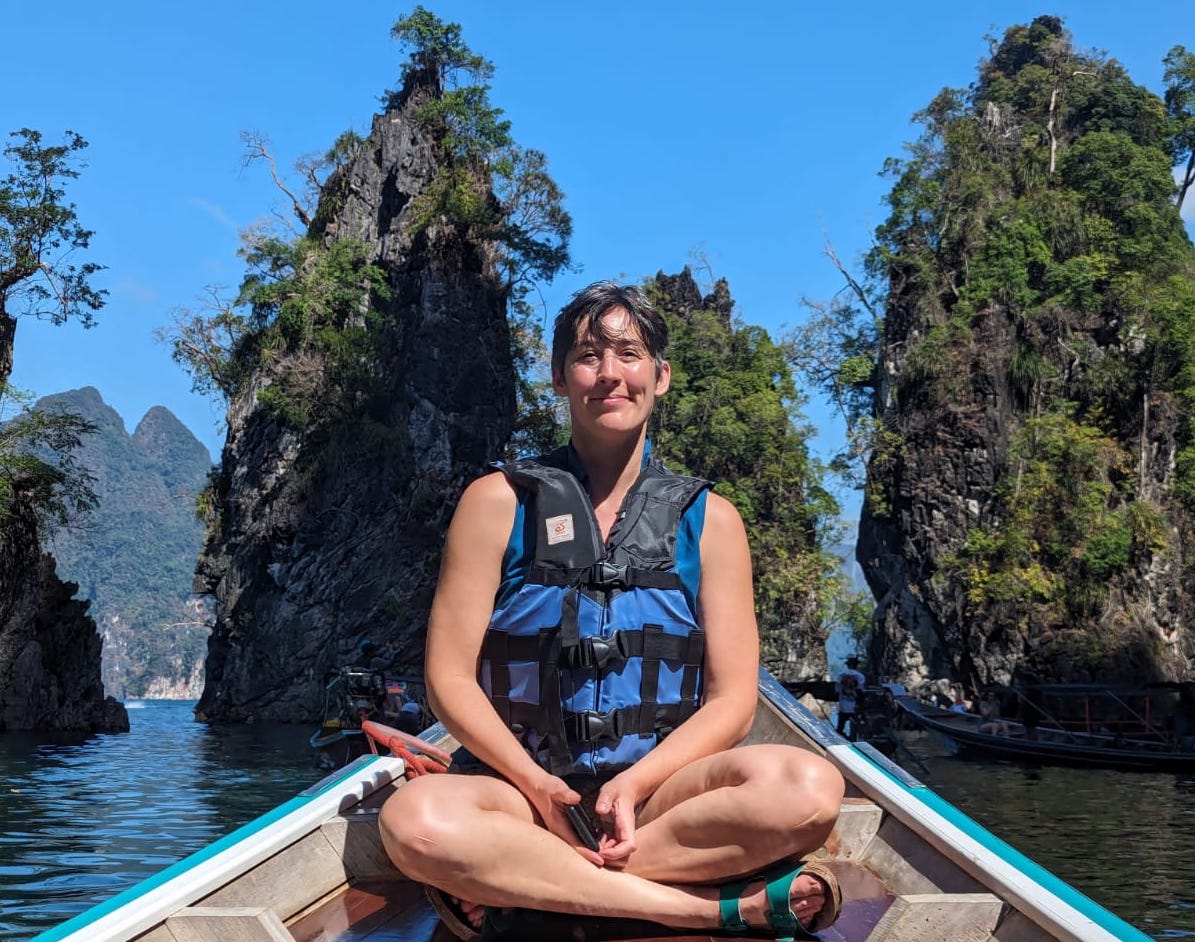I first visited Thailand a few years ago – a month of solo travel to avoid the rainy British winter. My first stop, Bangkok. I ate deep fried insects at Khao San Road and visited Siriraj Medical Museum, which exhibits grisly medical specimens in a decidedly maximalist fashion. I travelled south to visit a few of Thailand’s islands with a friend, then north to Chiang Mai and the small mountain town of Pai, which is popular with backpackers.
Last year I returned to Thailand on a hiking and kayaking trip, and visited the south of the country. We went to Cheow Lan Lake in Khao Sok National Park, a vast lake in the heart of Khao Sok National Park, where narrow karst islands jut out from the turquoise water. We spent the night in a floating bungalow, soaking up the tranquility and jumping into kayaks whenever we wanted to explore.
In Than Bok Khorani National Park, we kayaked down an emerald river, its water cloudy with calcified limestone from the nearby mountains. We climbed the 1,230 steps to the top of the Tiger Cave Temple in Krabi province, and relaxed on the beaches of Koh Yao Yai, a surprisingly peaceful island near Phuket.
Both trips provided me with a mixture of nature, culture, beautiful weather and the chance to eat my body weight in satay – all the hallmarks of a good trip. But even the best holidays could be made even better with the benefit of hindsight. Here are my travel tips for Thailand.

The Food Will Exceed Your Expectations

My favourite thing about Thailand? The food. After landing in Bangkok the second time, and taking a taxi to the city’s Chinatown, my first stop was at the street food stands lining Rama IV Road. I sampled delicious chicken skewers cooked over charcoal, served with pickled cucumber and satay sauce.
Our first lunch together, on Bangkok’s verdant river island of Bang Krajao, was a typical Thai feast. It consisted of a sour, spicy Tom yum seafood soup, fragrant papaya salad and stir fried fish. Crispy fried chicken wings and larb, spicy minced pork eaten with fragrant herbs, also featured. If that wasn’t enough, there was also mango and sticky coconut rice for dessert – a burst of sweet juice and rich coconut. This wasn’t a one-off. Pretty much every meal was a smorgasbord of colours, textures and flavours.
In Thailand, you’ll find the dishes that are served in restaurants in the west, like pad thai and penang curry. But it’s worth trying other dishes too. An unassuming bowl of sukiyaki soup (a Thai version of Japanese hotpot) with eggs and chicken was rich, salty comfort food. I enjoyed it so much I ended up ordering it twice.
You're spoilt for choice, so how do you choose? I always pick places that look like they're serving local clientele as well as tourists. When choosing street food, I tend to look for stands that are cooking food from scratch, rather than letting it sit out in the heat. I chose my satay place in Bangkok that first day because I watched the servers pull out the skewers from cool boxes, and then cook them on the grill to order. Plus, they smelled amazing.
There are Still Quiet Islands in Thailand

There are over 1,400 islands in Thailand, and millions of people visit them each year. In fact, 2.7 million visitors descended on Koh Samui, an island of 88.3 square miles (228.7 sq km). Meanwhile, Maya Bay on Phi Phi Ley island – featured in Hollywood film The Beach – became so popular that the Thai authorities closed it to tourists between 2018 and 2022, to help the environment recover from the effects of overtourism.
I didn’t want to share a beach with thousands of others or contribute to overtourism. I steered clear of the busier ‘party’ islands and sought out more tranquil spots. Such as Koh Phra Thong an island in the Andaman Sea with long golden sand beaches, and an interior landscape of mangroves and savannah. There are a couple of homestays, a beach bar or two – and that’s about it. We quickly slipped into ‘island time’ while there, spending our days swimming in the ocean and exploring the island.
It’s quiet because it’s a majority Muslim island. There isn’t much alcohol here, and it’s not a party place. Lots of people are put off by that.
A second island I recommend visiting is Koh Yao Yai. It’s only a 35-minute boat ride from Phuket, but despite the easy transport links, sees relatively few visitors.
“It’s quiet because it’s a majority Muslim island,” my guide Rit explained. “There isn’t much alcohol here, and it’s not a party place. Lots of people are put off by that.”
However, what Koh Yao Yai (mercifully) lacks in party vibes, it makes up for in natural beauty. We were taken to a deserted beach with a curving white sandbar that’s often compared to the Maldives. We kayaked inland through the twisting water channels in a mangrove forest, and took a guided hike where we learned about the island’s natural rubber production. Our local guide gave us handmade ‘seed bombs’ to catapult into the forest, helping regenerate the undergrowth.
It’s Really Solo-Friendly

The first time I visited Thailand, my month-long trip consisted of short meet ups with different groups of friends, and several stints of solo travel. I like travelling alone – in my early twenties I spent eight months solo in Mexico – and I have to say, Thailand was the easiest country to do it in.
There are several reasons for this. For a start, the infrastructure is excellent. Booking train and ferry tickets online is a doddle. Thailand also has a very safe, friendly feel. Of course, I can’t speak for other people, but I experienced zero harassment as a solo female traveller.
I experienced zero harassment as a solo female traveller.
Thailand is a popular destination for travellers in general, simply because it has so much to offer them. There are ancient temples for history lovers, delicious street food for foodies and those beaches. It also has plenty of opportunities for adventure, be that kayaking through a sea of karst islands or trekking through mountains and rainforests.
Because of this, there are plenty of ways for solo travellers to meet others on their journey. You can make new friends by going to a cooking class, going on a guided hike or simply striking up a conversation in your hostel.
It’s a Haven For Kayakers

Most people don’t come to Thailand for kayaking – myself included – but you should. Given that the south of the country borders both the Andaman Sea and Gulf of Thailand, opportunities for sea kayaking are numerous. We spent the day in Phang Nga Bay, using a longtail boat to get us far out to sea and then paddling over open waters around karst islands and into sea caves.
Than Bok Khorani National Park, in Krabi province, was another good place to take to the water. Located inland, it consists of thick forest braided with rivers, the water carving caves into the soft limestone. I enjoyed the contrast of tight mangrove channels, the wide, meandering river and the sea caves themselves, stalactite-covered roofs arching over calm lagoons. Several of the caves were even decorated with prehistoric paintings, which our guide pointed out with a torch as we glided through them.

A couple of tips, if you fancy going kayaking in Thailand. The first of these is to choose your tour operator wisely. We encountered several other kayaking groups whilst out on the water, and a lot of the time, the guides were the ones doing all the paddling. Of course, this is fine if you want to chill – but if you prefer being active and seeking out quieter routes, it’s worth doing your research.
The second is to go during the rainy season, or at the very start of the dry season. Water levels will be much higher during this time of year. We kayaked during the dry season, and in Khao Sok National Park the water levels were so low our kayaks were scraping against the river bed.
Easy Hikes Are Harder in the Heat


The second time I visited Thailand was in January. Daytime temperatures in the south were between 32°C and 36°C. This is an ideal temperature for swimming in the ocean or going sea kayaking. But it’s very hot for hiking, and you need to plan accordingly.
Our first hike in such temperatures took place in Cheow Lan, when we hiked to the top of one of the forested karst islands for a viewpoint over the lake. The hike was only three miles (5km) out and back, and the elevation was 250m. Easy, right? But we were all pouring sweat within minutes, thanks to the high temperature.

Climbing the 1,260 stone steps to the golden Buddha at the Tiger Cave Temple in Krabi was even more gruelling in the heat. I have a pretty good tolerance for hot weather, but by the time we descended I was so coated in sweat that I had completely soaked through my hiking clothes. Luckily there were some market stalls selling clothes outside the temple complex. I spent the rest of the day clad, rather uncharacteristically, in a pink tie dye dress.
My advice is to avoid hiking in the midday heat, and go at the beginning or end of the day instead. Temperatures will still be high, but the sun won’t be as fierce. Make sure to pack lots of water – even for short strolls – and some clothes to change into after your hike.
Beware the Monkeys!

As you enter the Tiger Cave Temple Complex, you’ll see a sign which reads ‘Please Do Not Feed the Monkey.’ As you mount the stone staircase up to the golden Buddha at the top, you’ll see another: ‘Beware of Monkeys Snatching Your Purse.’ Pay close attention to these signs. Anything that’s loose in your bag, be it a hat or the cord of a camera, the monkeys will try and take. If you’ve got food, they’ll try and pull it off you.
The best way to deal with the monkeys is the same way you would deal with a group of drunks: ignore, avoid, keep walking
When we were climbing the steps, there were troops of monkeys swarming up and down the railings and squaring up to tourists – reminiscent of a group of aggressive drunks anyone sober crosses the road to avoid. We were told that the monkeys were in a particularly bad mood at this time of year, the dry season, because of the heat.
The best way to deal with the monkeys is the same way you would deal with a group of drunks: ignore, avoid, keep walking. However, one of the tourists I saw on the steps did the opposite, and squared up to one of the monkeys. It didn’t go well. The monkey picked up an (emptyish) rubbish bin and threw it down the stairs. It narrowly missed us! So don’t try to be a tough guy. Just walk on by, keeping those snack bars hidden at the bottom of your bag.
Feeling inspired? Check out our Kayak and Hike Wild Thailand Adventure.



